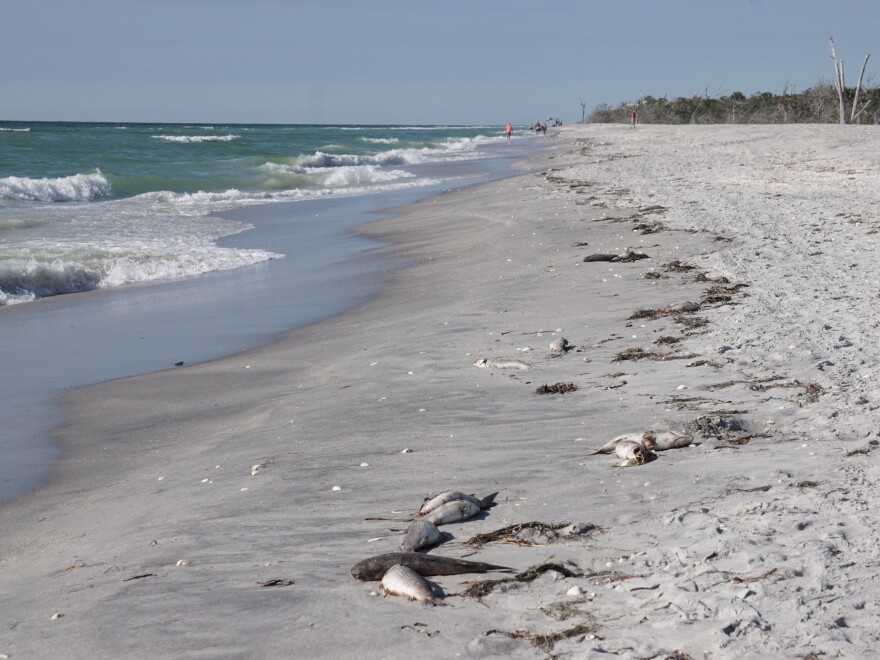When the water at Englewood Beach in Charlotte County is clear and beautiful, it’s a double dose of good news for beach resident and business owner Toby Delbridge.
He grew up with red tide, but it feels more intense these past few years.
“In high school, late '80s, I used to go out surfing, and you know, we didn't really understand it back then we just were getting choked by, you know, an algae bloom. Now, really, the algae blooms are just so much more pervasive. They've come into the back, the back waterways and different things, and they stay much longer,” said Delbridge.
He's been concerned about the potential effects of red tide.
“When you open your door and red tide is terrible outside. I mean it's -- you can't be outside.”
Delbridge, like other local business owners, also feel the impact financially.
Delbridge owns the Barefoot Trader and Beach Co., two shops in front of the beach. An intense bloom can hurt traffic coming into the business.
“If it's mentioned in the press, certainly, it'll drop by half,” said Delbridge.
To adjust, Delbridge might have to staff lighter and make sure staff is prepared to share information with visitors about red tide conditions.
Shelton Weeks, a professor of real estate at the Lutgert College of Business at Florida Gulf Coast University, says bad blooms affect tourism.
“When we have these extended blooms that are severe and stretch a significant distance up and down the coast, they become not just local stories, but national stories. And that has a direct impact on the number of visitors that will come to South Florida,” said Weeks.
The professor is helping to lead research of the impact these blooms have on tourism by comparing state data on red tide levels with numbers from Lee County’s visitor and convention bureau. That research is ongoing.
“What we saw on the data was that you start to see when those blooms are ongoing, the number of hotel nights falling in the region. So people are learning about these blooms, and it's impacting their decisions to potentially visit Southwest Florida,” said Weeks.
Weeks has personally felt the impact of media coverage
“We were recruiting a few years ago out in California, and talking to folks literally from all around the world. And we had folks from Asia and Australia ask us about red tide in Southwest Florida. They had been following it on the news. And we're very, very much aware of the problem we were having with the extended red tide bloom and blue green algae,” said Weeks.
That negative exposure can translate into huge losses in tourism, which is bad news for businesses. The devastating red tide in 2018 is estimated to have caused $130 million dollars in physical and economic damage in 12 counties, according to the Tampa Bay Regional Planning Council.
Boat captain Bruce LaMotte with Lemon Bay Tours, also in Englewood, says the red tides feel more frequent, but he has learned to adjust. Sometimes that means cancelling trips and finding other jobs to do or finding alternative spots to take customers.
“When we had that really nasty bloom, I probably wouldn't have had any trips at all back in 2017. But in that case, we had gotten so much rain, that the salinity up to the north was almost fresh. And so the algae doesn't grow in that stuff. And so the dolphins knew it. The birds knew it. And I knew it. And so I didn't even go south,” said LaMotte. He says that strategy led to some successful trips during that bloom.
Both Englewood business owners, LaMotte and Delbridge, said they want something done about issues that make the problem worse, like leaking septic tanks and discharges from Lake Okeechobee. They also agree that journalists could help in how they cover these blooms. They say red tide reports often just name a county when poor conditions can be isolated.
“Sometimes you don't even have it that bad at a certain beach, but people hear about it. And then they just don't show up at the beach, especially locals,” said Delbridge.
“There is frustration with how red tide is covered and reported. It's the nature of the beast that there always seems to be more coverage in the media when you hear that red tide has arrived, or the red tide cells have come up in numbers and you rarely see a headline or top of the news hour when you're back to normal so that that can be frustrating,” said Virginia Haley, president of Visit Sarasota County.
Haley also says there’s frustration when news outlets use file footage from 2018 to report on current red tide outbreaks, which can make the public think red tide conditions are worse than they really are. Haley says community leaders are trying to educate locals and visitors about how quickly red tide conditions can change.
“I think that we are making that impact with visitors. I think the beach condition reports have really helped. And I think the constant education -- that the tourism agencies are working with the chambers, with the hotels, and arming them with information, so visitors know, accurate information. We're not hiding that it's here,” said Haley.
LaMotte is hopeful that more visitors will take a look at those current beach reports so they don’t miss a tour with his business needlessly.
As for Delbridge, he said it’s time the governor also makes red tide a much bigger priority not just because of its impact on his community’s bottom line but on the quality of life.
“I would say red tide is probably No. 2 to hurricane preparedness in the state as far as something that the state should could consider,” said Delbridge.
Copyright 2023 WGCU. To see more, visit WGCU.



